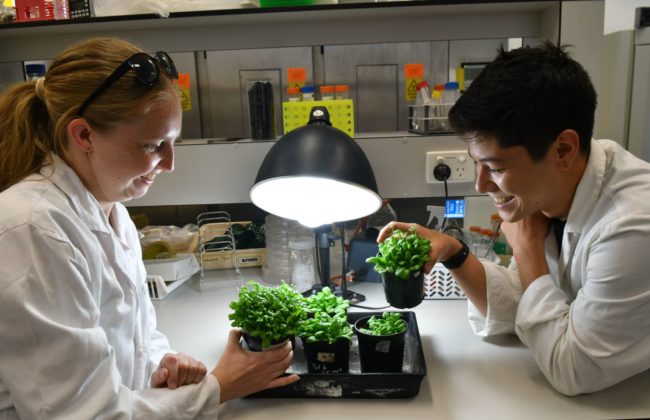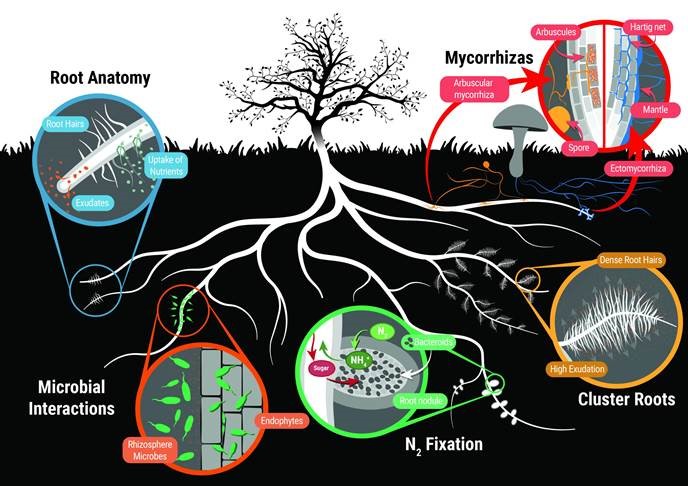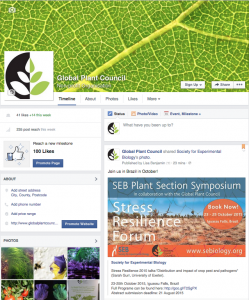


Alert: Teachers of plant physiology!
Have you ever wanted a free, on-line textbook written by experts and regularly updated?
Plants in Action is an on-line resource for students and academics teaching plant function to undergrads, published by the Australian and New Zealand societies of plant science. Each chapter has up to 100 illustrations suitable for Powerpoint presentations. It is also ideal for graduate students and post-docs in molecular biology looking for the whole-plant context for their work. Of the original 20 chapters, ten have been fully revised.
Here, we speak to Professor Susanne Schmidt (The University of Queensland) and Chief Editor Professor Rana Munns (CSIRO) about their work in developing this fantastic resource.
Could you begin by describing the Plants in Action (PiA) textbook and how the idea first came about?
The original editors and contributors produced a textbook on plant function that used examples from the southern hemisphere, with view of adaptations in nature to performance in cultivation. They were motived to communicate the strong plant science in Australia and New Zealand. PiA was born as a textbook in 1999, and ten years later went open-access and free online.
Who are your target audience?
Undergraduate students, educators, practitioners and researchers, and others interested in plants and how they function. PiA gets thousands of hits per day from around the globe, including developing countries.
What topics do you cover?
To the best of my knowledge, PiA is the only comprehensive plant science textbook with a southern hemisphere perspective. It covers molecular, cellular, and whole-plant function, in ecophysiology and vegetation-environment interactions, from Antarctica to the tropics. PiA features plants that are some of the best studied genetic models and crops, as well as wild plants.

The topics covered in Chapter 4: Nutrient uptake by plants involving beneficial microorganisms. Image credit: Scott Buckley, The University of Queensland.
Who has contributed to the textbook, and how did you enlist potential collaborators?
PiA was written by Australian and New Zealand plant scientists from a range of institutions, many of whom have worked on both editions. Chief Editor Dr Rana Munns and the chapter editors find new contributors if the original authors are not available, although occasionally authors volunteer contributions
What changes have you made in the second edition, and how are the revisions coming along?
PiA2 is being updated to reflect recent advances in plant science, and has a new look as software enables ever more attractive layouts, with no limit for images and illustrations. PiA can be read online and is easily printed, which is important for internet-challenged regions and for students wanting to add notes. Ten chapters are fully updated with several chapters expanded.
Revisions can be made instantly (as a wiki) but take a little longer if the expert skills of our IT assistants are required. Complete revisions of chapters are slower to come on board.
Encouragingly, some excellent contributions have recently been made by junior scientists who see a strong value in developing an open-access resource to share their expertise widely.
You mentioned the text can be translated into different languages. How might users go about getting a textbook in their native language?
They can contact the Australian Society of Plant Scientists (admin@asps.org.au) and receive Word or PDF versions of individual chapters, with permission to translate and reproduce.
The project is sponsored by the Australian and New Zealand societies of plants scientists, ACIAR, and the University of Queensland. Could you elaborate on how this funding was acquired, if possible?
ACIAR (Australian Centre for International Agricultural Research) was our first sponsor. They saw the value of an open-access resource, particularly for plant biologists in developing countries and the free exchange of knowledge. The University of Queensland (UQ) came on board to provide the host server as PiA supports teaching at UQ with strengths in agriculture and environmental science. Sponsorship was also provided by the Western Sydney University, the University of Western Australia, and the Australian Centre for Plant Functional Genomics. The societies of plant science in Australia and New Zealand are ongoing supporters and PiA remains predominantly the product of their members.
Are you looking to expand on the work in the future? How can potential contributors get involved?
It would be marvelous to have a person with time and expertise to develop further materials to add to PiA2 in collaboration with editors, authors, educational designers, and students. This could include material specifically designed for schools and interactive learning tools for students of all levels. We welcome all contributors (irrespective of their connections to the plant societies), and they can contact Rana or any chapter editor.
Without plants, Earth would not give us habitat, food and materials. But with 25% of the global flora threatened with extinction, we need more people to understand plants, and what we need to do protect them and their habitats.
The first edition of Plants in Action was published by the Australian and New Zealand societies of plant science as a hardcover book in 1999, which is also now free on-line (http://plantsinaction.science.uq.edu.au/edition1/).
The PiA text can be translated into other languages. Please direct enquiries to the Chief Editor Professor Rana Munns via the Australian Society of Plant Scientists: admin@asps.org.au.
All images are courtesy of the Plants in Action team, and are used with permission.
 – we’re even helping to develop a new social media platform just for plant scientists! As well as this blog, we also have two Twitter accounts: our main, English-language account is at @GlobalPlantGPC, to which myself (@lisaamartin1), Ruth (@plantscience), and GPC New Media Fellows Amelia (@AmeliaFrizell) and Sarah (@josesci) all contribute. Alternatively, if you speak Spanish we also have a Spanish-language account at @GPC_EnEspanol (operated by Ecuadorian-PhD-student-in-Germany Juan-Diego Santillana-Ortiz; @yjdso, who kindly translates our tweets).
– we’re even helping to develop a new social media platform just for plant scientists! As well as this blog, we also have two Twitter accounts: our main, English-language account is at @GlobalPlantGPC, to which myself (@lisaamartin1), Ruth (@plantscience), and GPC New Media Fellows Amelia (@AmeliaFrizell) and Sarah (@josesci) all contribute. Alternatively, if you speak Spanish we also have a Spanish-language account at @GPC_EnEspanol (operated by Ecuadorian-PhD-student-in-Germany Juan-Diego Santillana-Ortiz; @yjdso, who kindly translates our tweets).
We find Twitter a great way to share links, news, journal articles and conference updates, while also networking with the global plant science community. Join over 1000 other plant scientists and enthusiasts and follow us, if you’re not already!
If you’re not sure where to start with Twitter, Mary Williams from ASPB (@PlantTeaching) has written a great two-part blog (we feature in Part 1! And here’s Part 2) that will help you get started and understand the ‘twetiquette’ of tweeting, especially from conferences.
Although Facebook is by far the most popular social networking site across the globe, the way we use it has evolved dramatically since its inception in 2004. ‘Thefacebook’ as it was first known, was famously founded by Harvard University student Mark Zuckerberg as a way for his fellow students to view and comment on photographs of their dorm-mates. Initially restricted to Harvard, the website soon expanded to universities across the US, then the world, and now almost anyone can use it, even without an academic email address.
 But Facebook has moved on from its early days and it’s now not all about ‘poking’ your friends (remember that?!). Now worth billions of dollars, Facebook has morphed into an all-encompassing platform for both recreation and business. While many people still use Facebook to keep in touch with friends and family, share photos and status updates, it’s also increasingly being used to share news, articles and opinions, to play games, form groups or communities, and as a tool for companies and organizations to interact with and advertise to customers or members.
But Facebook has moved on from its early days and it’s now not all about ‘poking’ your friends (remember that?!). Now worth billions of dollars, Facebook has morphed into an all-encompassing platform for both recreation and business. While many people still use Facebook to keep in touch with friends and family, share photos and status updates, it’s also increasingly being used to share news, articles and opinions, to play games, form groups or communities, and as a tool for companies and organizations to interact with and advertise to customers or members.
At the Society for Experimental Biology conference in Prague in June, I heard several scientists extolling the benefits of social media, particularly – and perhaps unsurprisingly – in the Education and Outreach sessions. I was particularly interested to repeatedly hear the message that Facebook is a very useful tool for science communication and outreach – so we’ve decided to try it!
Having only ever used Facebook for personal uses, Sarah and I asked some prolific social media users for their advice on starting and using a Facebook page, and in answer to the question, “Why should we bother with Facebook?”, the overwhelming message was clear: Facebook is used by more, different people.
Compared to Twitter, which has around 316 million users, Facebook reached its 1 billionth account in 2012, and while the people we spoke to find that most of their Twitter followers are from English-speaking countries, their Facebook visitors represent a much broader range of geographic locations and languages. Furthermore, unlike setting up and maintaining a website, it’s free to set up Facebook pages or groups, so some organizations only exist on social media. By setting up a Facebook page for the GPC, we should, in theory, be able to interact with more people than we would with just our Twitter accounts and blog, thus we will be able to share and promote plant science all over the world more effectively and to a greater diversity of people.
If you’re attending our SEB Plant Section Symposium on Stress Resilience, you can also let us know by joining our Facebook event! (Please note however, that saying you’re coming to the meeting on Facebook is not the same as registering! You’ll need to do that here.)
Here’s a list of some of our Member Organizations who also have a presence on Facebook. Let us know if there are any other pages we should ‘like’! We’re also interested to hear from you if you have any thoughts about using social media, or suggestions of content you would like to see on Facebook. How do you use Twitter and Facebook, and how does your use of these channels differ, if at all? Please comment below!